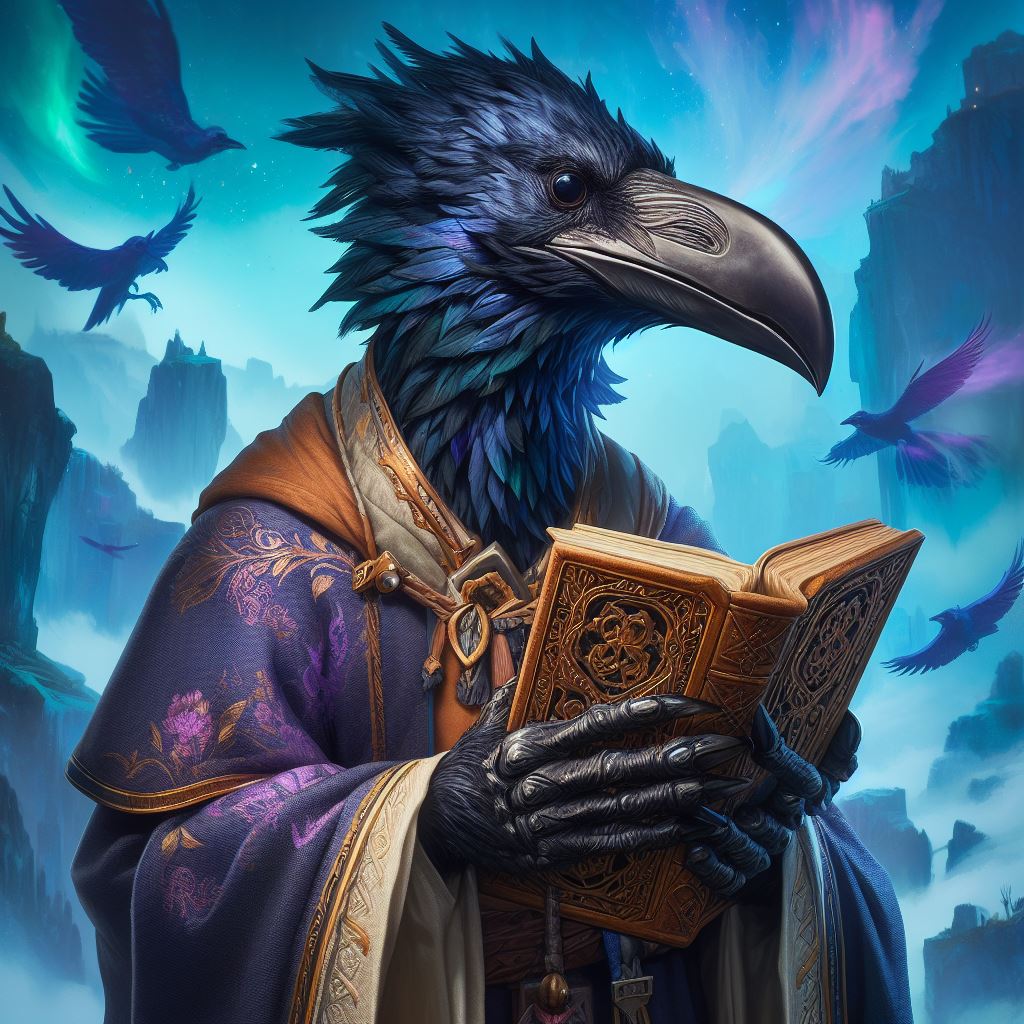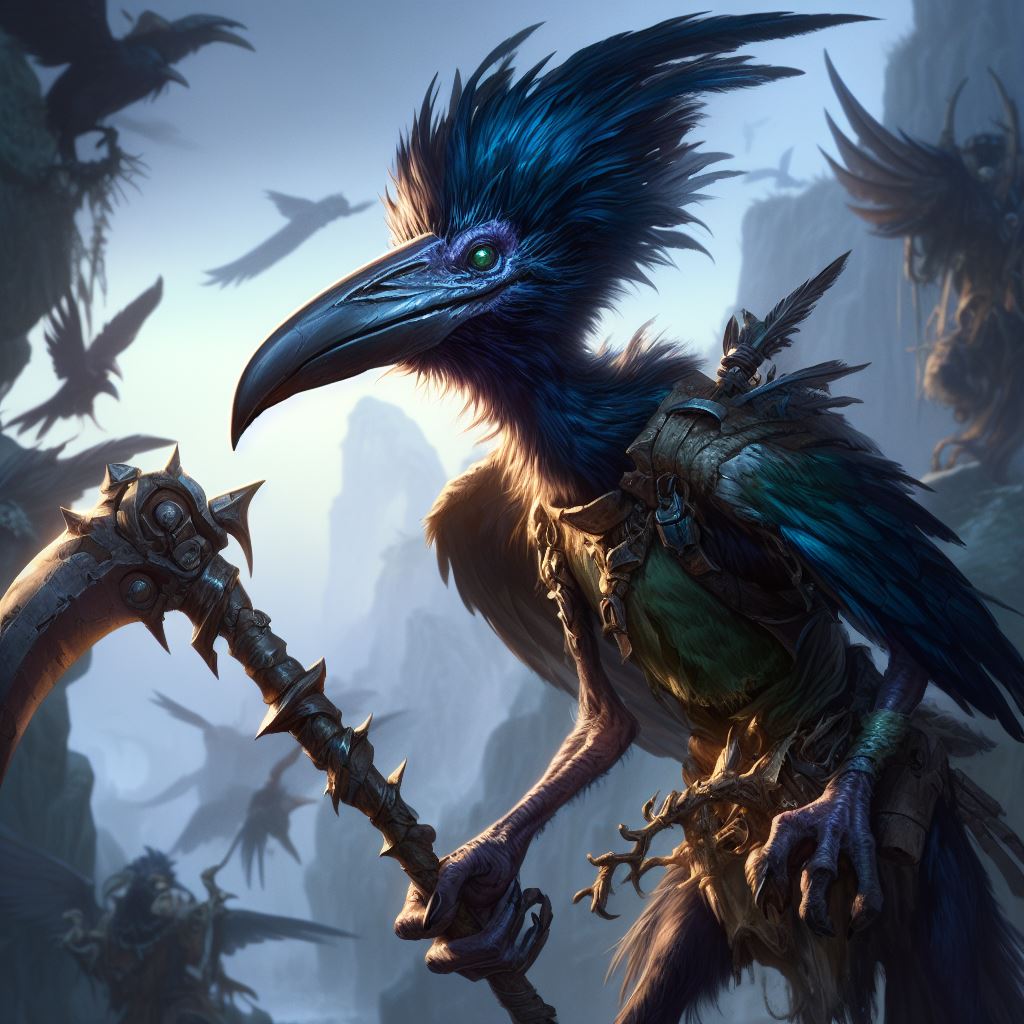Medium humanoid (kenku), chaotic neutral
Armor Class 13
Hit Points 13 (3d8)
Speed 30 ft.
Proficiency Bonus +2
Proficiency Bonus +2 (5th Edition Advanced Mode)
| STR | DEX | CON | INT | WIS | CHA |
|---|---|---|---|---|---|
| 10 (+0) | 16 (+3) | 10 (+0) | 11 (+0) | 10 (+0) | 10 (+0) |
Saving Throws (suggested) Dex +5
Skills Deception +4, Perception +2, Stealth +5
Senses passive Perception 12
Languages understands Auran and Common but speaks only through the use of its Mimicry trait
Challenge 1/4 (50 XP)
Ambusher. In the first round of a combat, the kenku has advantage on attack rolls against any creature it surprised.
Mimicry. The kenku can mimic any sounds it has heard, including voices. A creature that hears the sounds can tell they are imitations with a successful DC 14 Wisdom (Insight) check.
ACTIONS
- Shortsword. Melee Weapon Attack: +5 to hit, reach 5 ft., one target. Hit: 6 (1d6 + 3) piercing damage.
- Shortbow. Ranged Weapon Attack: +5 to hit, range 80/320 ft., one target. Hit: 6 (1d6 + 3) piercing damage.
5th Edition Advanced Mode
Limiting the power of a character and making the overall difficulty of the game harder, does not reduce the creativity, indeed it does quite the opposite.
The Game Master has the option to use any and all of the instances proposed in this guide, or just some of them according to their preference.
It is the lack of something that move and motivate characters, not the abundance of it
DESCRIPTION
Kenku are a race of flightless avian humanoids that resemble ravens, crows, or hawks. They have black or brown feathers, beaks, and talons, and stand about 5 to 7 feet tall. They have no wings, but instead have arms and hands that can manipulate objects. They have partially hollow bones, making them lighter and more agile than most creatures of their size. Kenku wear simple brown robes to conceal their tools and weapons.
Kenku have a unique trait that sets them apart from other races: they have no voice of their own. They can only communicate by mimicking sounds they have heard, such as words, animal noises, or environmental sounds. They can perfectly imitate any sound they have heard, but they cannot create new sounds or speak with originality. This is because they were cursed by an ancient deity they once served, who took away their ability to fly and speak as punishment for their betrayal. Some kenku may also communicate with each other telepathically, using a form of mental speech that only they can understand.
COMBAT
Kenku are not very strong, but they are cunning and resourceful fighters. They prefer to use stealth and surprise to gain an advantage over their enemies, rather than engaging in direct confrontation. They often work in small gangs or with allies, using their mimicry or telepathy skills to coordinate their attacks or confuse their foes. They are adept at using a variety of weapons, such as daggers, short swords, crossbows, or slings. They also make use of traps, poisons, or other dirty tricks to gain an edge in combat.
Kenku are opportunistic and unscrupulous, and will not hesitate to flee or surrender if the odds are against them. They value their own survival above all else, and will not risk their lives for a cause or a friend. They are also prone to betrayal and treachery, and will switch sides or sell out their allies if it benefits them. Kenku are not loyal or trustworthy, and will only cooperate with others as long as it serves their interests.
HABITAT / SOCIETY
Kenku are nomadic and wanderlustful, roaming the lands in search of wealth and power. They have no permanent settlements or territories of their own, but often live in large human cities, especially in southern Faerûn. There they work as spies, assassins, thieves, or other shady professions, taking advantage of the urban chaos and corruption. Kenku are secretive and elusive, hiding their true nature and motives from others. They often adopt disguises or aliases to blend in with the crowd or avoid detection. Kenku have no culture or traditions of their own, but instead mimic those of other races they encounter.
Kenku have no sense of community or kinship among themselves. They operate in small gangs or factions that compete or cooperate with each other depending on the situation. Kenku have no leaders or authority figures, but instead follow the strongest or the smartest among them. Kenku have no morals or ethics, but instead follow a code of self-interest and pragmatism. They will do anything to achieve their goals, regardless of the consequences for others. Kenku have no dreams or aspirations of their own, but instead covet those of others. They will steal or copy anything that catches their eye, such as objects, ideas, or identities. Kenku are driven by a deep sense of envy and resentment towards those who have what they lack: wings and voices.
Kenku may appear to be friendly, helpful, and even generous to humans and demihumans. They freely give treasure to them, but it is rarely genuine and crumbles into dust within a day. They may offer nonverbal advice to them, but this is carefully designed to mislead. It may actually lead them into dangers and difficulties they might otherwise have avoided.
ECOLOGY
Kenku are omnivorous scavengers that can eat almost anything they find. They prefer meat over plants, and will hunt small animals or steal food from others if they can. They have no preference for any particular climate or terrain, but tend to avoid extreme environments that are too hot, cold, wet, or dry. Kenku are adaptable and resilient creatures that can survive in most conditions.
Kenku have a low reproductive rate and a short lifespan compared to other races. They reach maturity at around 10 years old and rarely live past 60 years old. They mate for convenience rather than love, and have no attachment to their offspring. Kenku lay eggs that hatch after a few weeks into featherless chicks that can walk and talk within a few days. Kenku parents provide minimal care for their young until they can fend for themselves.
Domestically raised kenku are prized as servants. Kenku eggs are commonly sold for 250 gp, hatchlings for 300-500 gp. However, this is a form of slave trade, with all the attendant complications. If a kenku discovers captive kenku, it will attempt to secretly rescue the captive and, if possible, kidnap the slave trader or owner. They will avenge slain kenku.
Kenku: The Crowfolk of D&D
Kenku are a race of humanoid birds that appear in the Dungeons & Dragons (D&D) fantasy role-playing game. They are based on the mythological creatures of the same name from Japanese folklore, which are said to be able to mimic any sound they hear. Kenku have black feathers, beaks, and claws, and they can only speak by imitating sounds they have heard before. They are often depicted as cunning, curious, and mischievous, but also as loyal, cooperative, and adaptable. Kenku have a strong connection to the Raven Queen, a mysterious goddess of death and fate, who is said to have created them as her servants. However, some legends also say that the kenku were cursed by the gods for their greed and ambition, and that they lost their ability to fly and their original voices. Kenku come in different breeds or variants, each with their own characteristics and traits. Here are some of the most common kenku variants:
Ravens: Ravens are the most ancient and revered of the Kenku, tracing their lineage back to the original servants of the Raven Queen. They are large r and stronger than other Kenku, with thick beaks and shaggy necks. They have a deep and raspy voice that can mimic almost any sound. Ravens are often seen as leaders or elders among the Kenku, and they prefer to dwell in mountainous or forested regions.

Grackles: Grackles are a flashy and flamboyant breed of Kenku, with iridescent black feathers that shine in different colors. They have long tails, yellow eyes, and pointed beaks. Grackles are very social and gregarious, often forming large flocks and making a lot of noise. They are also very curious and adventurous, always looking for new sights and experiences. Grackles are common in urban areas, where they can find plenty of food and entertainment.

Magpies: Magpies are a medium-sized and mischievous breed of Kenku, with black and white feathers and a long tail. They have blue or green iridescence on their wings and tail. Magpies are very playful and pranksterish, always looking for fun and amusement. They are also very greedy and acquisitive, always collecting shiny or valuable objects. Magpies are found in many parts of the world, where they feed on insects, seeds, fruits, eggs, and small animals.
